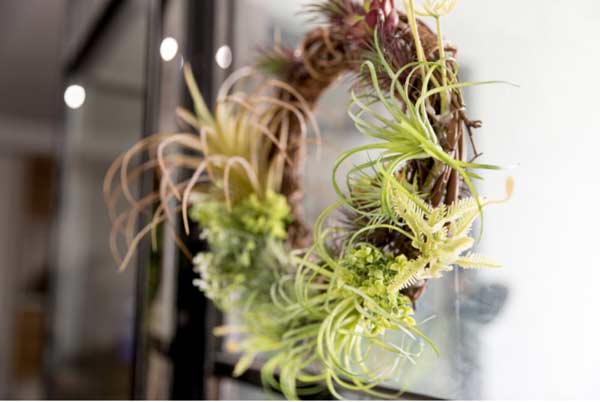Air Plant: Grow & Care for Tillandsia
Written by Iris
Oct 20 2021
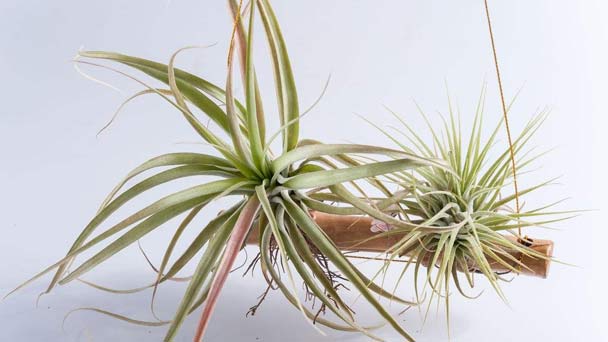
Air Plant (Tillandsia) comes from Mexico and South America. Air Plant (Tillandsia) are so named because they use their short, strong roots on branches, cliffs, and even power lines and telephone lines, rather than in the soil.
If you do decide to go the route of displaying your plant in a terrarium, look for one that is not fully enclosed, as your plant needs exposure to air movement and nutrients. (Find more best indoor hanging plants here.)
It's important to avoid any containers made of copper, as the mineral is toxic to air plants. Pressure-treated lumber also contains chemicals that are made of copper, so if you’re putting your plants inside any wood container, be mindful of this as well.
Lastly, do not place your air plant in soil with non-air plants. You might think that it won’t have an impact since these little critters feed off air, water and sunlight, but throwing them in some soil can cause their roots to rot.
Old tights or stockings stretched over a wire frame, or chunks of tree fern fibre can be used as a substrate for germination
Spread the seeds thinly so that they have plenty of space and are not touching as this helps when moving them on without damaging them once they have reached manageable size, as well as enabling the seedlings to grow larger
Keep in strong but diffused light, good air circulation, high humidity and a temperature of approx. 25°C (75°F) for germination
For the first two years or so, the plants require the same growing conditions as for germination
Water by misting heavily whenever the surfaces of the young plants appear dry
Feed weekly with an orchid feed or a regular liquid feed at one quarter strength
Avoid keeping the substrate too moist as this will cause development of algae that can suffocate the young plants
Once the plants have reached 1.25cm (½in) in height, they are ready to be separated onto individual pieces of substrate to grow on to flower 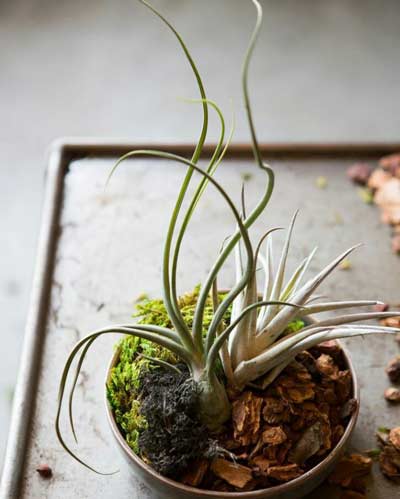
In case your Tillandsias become too dry or desiccated, they will benefit from an occasional soaking in a bucket of water overnight (do not do this with Tillandsia Xerographica, Streptophylla, or Magnusiana, as this may result in leaf damage). However, for routine watering, they should be able to dry out in 4 hours or less to avoid rotting. We prefer to use reverse osmosis water with a dilute solution of fertilizer every time we water.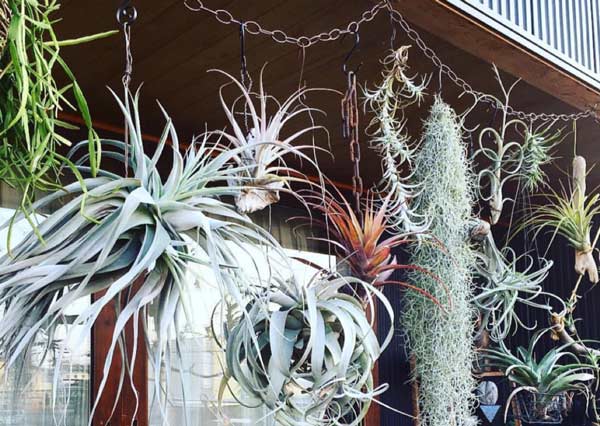
'Inoantha,' also called a sky plant, has spiky leaves that start out silver-hued and turn a deeper shade of green as the plant matures. Native to Mexico and Costa Rica, it shoots out a striking yellow or white flower. Common varieties include ‘Guatemala,’ ‘Mexican’ and ‘Rubra.’
'Aeranthos' is native to Brazil, Paraguay and Argentina. This spiky little plant produces a pink bud that opens into a deep purple flower. Varieties include ‘Grey Ghost,’ ‘Bronze,’ ‘Black,’ and ‘Purple,’ after the colors of their leaves.
'Streptophylla,' also know as Shirley Temple for its curly mane of leaves, likes drier conditions than other air plants.
'Latifolia' is one of the largest air plants, a spiky plant that grows up to 18 inches tall. It produces a tall, red bloom spike.
'Xerographica,' known as Xeros, are everyone’s favorite. These natives of Mexico have silver leaves that curl and spiral around themselves as they grow.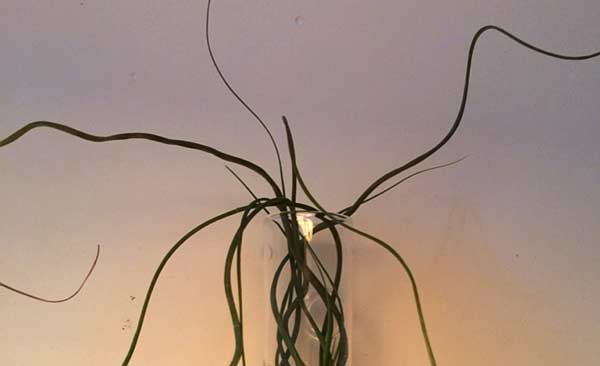
Sometime around the time of bloom, air plants also produce offsets, or young daughter plants. Separate these offsets from the mother plant by twisting or cutting them off. Move the young offset to a new location when it's about half the size of the mother plant.
As you now see, just because air plants are considered low maintenance doesn’t mean you can completely ignore them. Proper air plant care is essential to enjoying these unique little plants for many years to come.
Where to Grow Air Plant (Tillandsia)How to Grow Air Plant (Tillandsia)Air Plant Propagation with SeedsAir Plant Propagation with Stem PupsHow to Care for Air Plant (Tillandsia)Air Plant Lighting RequirementsAir Plant WateringAir Plant Temperature & Humidity CareAir Plant FertilizerAir Plant Pests & DiseasesVarieties of Air Plant (Tillandsia)Air Plant (Tillandsia) FAQAre air plants hard to take care of?Why is your air plant dying?Do air plants bloom?
Where to Grow Air Plant (Tillandsia)
Just like picking an air plant variety, there are many ways to put your new plant baby on display. From macramé and baskets to glass terrariums or wooden bowls, you’ll no doubt find something that reflects your own personal style.If you do decide to go the route of displaying your plant in a terrarium, look for one that is not fully enclosed, as your plant needs exposure to air movement and nutrients. (Find more best indoor hanging plants here.)
It's important to avoid any containers made of copper, as the mineral is toxic to air plants. Pressure-treated lumber also contains chemicals that are made of copper, so if you’re putting your plants inside any wood container, be mindful of this as well.
Lastly, do not place your air plant in soil with non-air plants. You might think that it won’t have an impact since these little critters feed off air, water and sunlight, but throwing them in some soil can cause their roots to rot.
How to Grow Air Plant (Tillandsia)
Air Plant Propagation with Seeds
Seeds of Tillandsia need warmth, moisture, light, and good air circulation for germination and survival;Old tights or stockings stretched over a wire frame, or chunks of tree fern fibre can be used as a substrate for germination
Spread the seeds thinly so that they have plenty of space and are not touching as this helps when moving them on without damaging them once they have reached manageable size, as well as enabling the seedlings to grow larger
Keep in strong but diffused light, good air circulation, high humidity and a temperature of approx. 25°C (75°F) for germination
For the first two years or so, the plants require the same growing conditions as for germination
Water by misting heavily whenever the surfaces of the young plants appear dry
Feed weekly with an orchid feed or a regular liquid feed at one quarter strength
Avoid keeping the substrate too moist as this will cause development of algae that can suffocate the young plants
Once the plants have reached 1.25cm (½in) in height, they are ready to be separated onto individual pieces of substrate to grow on to flower
Air Plant Propagation with Stem Pups
Propagating Tillandsia is simple. However, this variety of air plants is not as prolific as others, so you may only see one or two pups once it is mature. Once you see these pups, you can easily remove them to create more air plants. Here is how:- When the pup is at least a third the size of the parent plant, it is mature enough to separate.
- Identify the pup's base, where it is attached to the parent plant.
- Gently separate the pup off the parent plant. Aim to pull the pup from its base leaves so you don't damage the top leaves. You may need to use a sharp knife or scissors if the pup doesn't easily detach.
- Once the pup is separated, place in a well ventilated, bright spot of its own.

How to Care for Air Plant (Tillandsia)
Air Plant Lighting Requirements
Usually Air Plants in their natural conditions thrive live under the canopy or shelter of other plants and prefer filtered sunlight. Indoors or close to a window setting is an ideal location. Another good option is artificial light. Try to keep your air plants close to the artificial light. This plant species does not require a day/night cycle, so you can turn off the lights at night.Air Plant Watering
Watering air plants is the trickiest part of taking good care of them. But as a rule of thumb, water your air plant thoroughly at least 2 to 3 times a week. However, in a dry, hot climate, on the other hand, you may need to water them as much as 2 times a day, or once or twice a week in a cool, humid environment.In case your Tillandsias become too dry or desiccated, they will benefit from an occasional soaking in a bucket of water overnight (do not do this with Tillandsia Xerographica, Streptophylla, or Magnusiana, as this may result in leaf damage). However, for routine watering, they should be able to dry out in 4 hours or less to avoid rotting. We prefer to use reverse osmosis water with a dilute solution of fertilizer every time we water.
Air Plant Temperature & Humidity Care
Native to warm, tropical locales, Tillandsia prefer warm days (70° to 80°F) and cooler nights (50° to 60°F).High humidity and good air circulation are vital for Air Plant health, so keep them far from drying air sources like heating vents, appliances and fireplaces. A good practice is to mist or shower your plants at least twice a week. Their vase-shape helps them capture and store water.Air Plant Fertilizer
Fertilizing your air plants is not strictly necessary, but it does lead to better health, better growing and better blooming. Well fed air plants also are better able to adapt to challenging conditions, like a 2 week vacation without watering, a heat wave, etc. Use a fertilizer specifically formulated for bromeliads or air plants once a month, or dilute Miracle-Grow or similar water soluble plant foods to 1/4 strength. Add the fertilizer water to a spray bottle, and mist thoroughly with the food water once a month.Air Plant Pests & Diseases
Look out for mealybugs and scale insects on air plants. If your plant gets an infestation, treat it with a Tillandsia-safe pesticide. Dampness is the enemy of air plants. Remember, the secret of air plant care is getting the water right. Too much moisture will cause a plant to rot from the inside out. Leaf rot or fungal diseases can also be a problem when air plants are too damp.
Varieties of Air Plant (Tillandsia)
'Bulbosa' looks like a sea creature, with a bulb-shaped base and tentacle-like leaves. Varieties include ‘Guatemala’ and ‘Belize.’'Inoantha,' also called a sky plant, has spiky leaves that start out silver-hued and turn a deeper shade of green as the plant matures. Native to Mexico and Costa Rica, it shoots out a striking yellow or white flower. Common varieties include ‘Guatemala,’ ‘Mexican’ and ‘Rubra.’
'Aeranthos' is native to Brazil, Paraguay and Argentina. This spiky little plant produces a pink bud that opens into a deep purple flower. Varieties include ‘Grey Ghost,’ ‘Bronze,’ ‘Black,’ and ‘Purple,’ after the colors of their leaves.
'Streptophylla,' also know as Shirley Temple for its curly mane of leaves, likes drier conditions than other air plants.
'Latifolia' is one of the largest air plants, a spiky plant that grows up to 18 inches tall. It produces a tall, red bloom spike.
'Xerographica,' known as Xeros, are everyone’s favorite. These natives of Mexico have silver leaves that curl and spiral around themselves as they grow.

Air Plant (Tillandsia) FAQ
Are air plants hard to take care of?
Caring for air plants is only a challenge if you don’t start off on the right foot. According to NYBG Certified Horticulturist Bliss Bendall, it’s important to be very specific about the kind of air plant you choose because not all have the same requirements or grow under the same exact conditions. “It is vital to do your research on the variety of Tillandsia species you want way ahead of time,” she says. As long as you are meticulous, your air plants can grow and thrive.Why is your air plant dying?
There are many reasons why air plants don't last. Chances are, you either under- or over-watered it or accidentally used soft water. Cold air can also lead to the demise of air plants. If air plants get too cold for a consistent 24-hour period below its planting zone, that can also cause them to die. Low air circulation and lack of humidity can also kill plants.Do air plants bloom?
Lucky houseplant lovers who learn how to care for air plants properly are often gifted with blooms from their air plants. Most species of Tillandsia bloom only once in their life. Blooms spikes can be pink, purple, white, orange, red, or yellow, and typically occur in late winter or spring.Sometime around the time of bloom, air plants also produce offsets, or young daughter plants. Separate these offsets from the mother plant by twisting or cutting them off. Move the young offset to a new location when it's about half the size of the mother plant.
As you now see, just because air plants are considered low maintenance doesn’t mean you can completely ignore them. Proper air plant care is essential to enjoying these unique little plants for many years to come.
Latest Updated
- Benefits of Bugleweed - 7 Science-backed Health Benefits
- Bugleweed Dangers & Side Effects - Is It Poisonous?
- How to Plant Evergreen Trees - What You Should Know
- When to Plant Evergreens - Grow Guide for Evergreen Trees
- 12 Wonderful Evergreen Shrubs for Your Garden
- 12 Popular Evergreen Plants with Pictures for Beginners
- When And How To Prune A Lilac Bush Like a Pro
- How to Grow & Care for Lilac Vine (Hardenbergia Violacea)
- Japanese Lilac Tree (Syringa Reticulata) Care & Propagation Guide
- Shumard Oak Pros and Cons - What to Know
Popular Articles
- Winter maintenance of Antirrhinum Majus
- How to Grow Terminalia Mantaly Tree
- How to Grow and Care for Crossostephium Chinense
- How to grow Antirrhinum Majus in spring
- Peristeria Elata (Dove Orchid) Profile: Info & Care Guide
- Underwatered Snake Plant (Sansevieria Trifasciata) - Signs And How To Fix
- How to Care for Brazilian Jasmine Plant (Mandevilla Sanderi)
- How to Grow & Care for Graptopetalum Purple Delight in Summer
- Rosa Chinensis (China Rose): Plant Growing & Care Tips
- How to Care for Baby Sun Rose (Aptenia Cordifolia)
